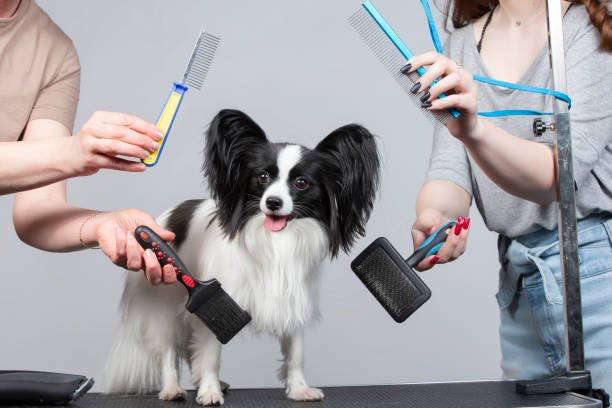Top 10 Essential Grooming Tools Every Dog Owner Needs
Introduction: Grooming your canine companion is more than just a routine; it’s a crucial aspect of their overall health and well-being. As a responsible dog owner, having the right grooming tools at your disposal can make the grooming process smoother, more efficient, and even enjoyable for both you and your furry friend. In this comprehensive guide, we’ll delve into the top 10 essential grooming tools that every dog owner should have in their grooming kit, exploring their importance and how to use them effectively.
1. Slicker Brush: The slicker brush is a versatile grooming tool suitable for dogs of all breeds and coat types. Its fine wire bristles effectively remove loose hair, dirt, and debris from your dog’s coat, preventing matting and tangling. Regular brushing with a slicker brush stimulates blood circulation, distributes natural oils, and promotes a healthy, shiny coat.

2. Undercoat Rake: For breeds prone to shedding, an undercoat rake is indispensable. This tool reaches deep into the undercoat to remove loose, dead hair and reduce shedding. By thinning out the undercoat, the rake helps prevent mats and keeps the coat looking neat and tidy. Regular use of an undercoat rake also promotes airflow to the skin, reducing the risk of skin issues.
3. Nail Clippers: Proper nail care is essential for your dog’s comfort and mobility. Nail clippers designed specifically for dogs come in various styles, including guillotine, scissor, and grinder types. Trimming your dog’s nails regularly helps prevent overgrowth, which can lead to discomfort, difficulty walking, and even joint issues. Be sure to use sharp, quality clippers and trim only the tip of the nail, avoiding the quick—the sensitive blood vessel and nerve inside the nail.
4. Ear Cleaner: Maintaining clean ears is vital for preventing ear infections and discomfort in dogs. A dog-specific ear cleaner helps dissolve wax, remove debris, and inhibit bacterial growth, promoting good ear health. Regular ear cleaning also allows you to inspect for signs of infection, such as redness, swelling, or odor. Use a gentle, non-irritating ear cleaner and cotton balls to clean the outer ear canal, avoiding the delicate eardrum.
5. Toothbrush and Toothpaste: Dental hygiene is often overlooked but is crucial for your dog’s overall health. Brushing your dog’s teeth regularly helps prevent plaque buildup, tartar formation, and gum disease. Use a dog-specific toothbrush and toothpaste formulated for pets, as human toothpaste can be harmful if swallowed. Aim to brush your dog’s teeth several times a week to maintain optimal oral health.

6. Comb: A quality comb is an essential grooming tool for detangling your dog’s coat and removing mats and knots. Unlike brushes, combs have finer teeth that penetrate deeper into the coat, making them ideal for breeds with long or thick fur. Regular combing helps prevent mats and tangles, reduces shedding, and keeps the coat looking smooth and shiny. Choose a comb with rounded teeth to prevent scratching or irritating your dog’s skin.
7. Dog Shampoo: Choosing the right shampoo is essential for keeping your dog’s coat clean, healthy, and smelling fresh. Look for a dog-specific shampoo formulated for your dog’s skin and coat type, whether they have sensitive skin, allergies, or specific grooming needs. Avoid using human shampoo, as it can strip away natural oils and disrupt the pH balance of your dog’s skin, leading to dryness, itching, and irritation.
8. Dog Conditioner: Conditioning your dog’s coat after shampooing helps restore moisture, soften the fur, and reduce tangles. A dog conditioner formulated for pets contains ingredients that nourish the hair, such as natural oils, vitamins, and proteins. Apply conditioner evenly throughout your dog’s coat, focusing on dry or damaged areas, and leave it on for a few minutes before rinsing thoroughly. Conditioning regularly helps keep your dog’s coat healthy, manageable, and free from static.
9. Grooming Scissors: Grooming scissors are handy for trimming your dog’s fur between professional grooming sessions. They’re ideal for tidying up around the eyes, ears, paws, and sanitary areas, as well as shaping the coat for aesthetic purposes. Choose grooming scissors with sharp, stainless steel blades and comfortable handles for precise, controlled trimming. Use caution when trimming sensitive areas, such as around the eyes or genitals, and always work in well-lit conditions.
10. Styptic Powder: Accidents can happen during nail trimming, leading to bleeding if you accidentally cut the quick—the sensitive blood vessel and nerve inside the nail. Styptic powder is a lifesaver in such situations, as it helps stop bleeding quickly and promotes clotting. Simply apply a small amount of styptic powder to the bleeding nail, using gentle pressure to stem the flow. Keep styptic powder on hand in your grooming kit for peace of mind during nail care sessions.
Conclusion: Equipped with these top 10 essential grooming tools, you’ll be well-prepared to care for your dog’s grooming needs at home. Regular grooming not only keeps your dog looking and feeling their best but also strengthens the bond between you and


